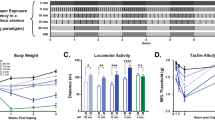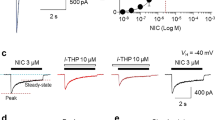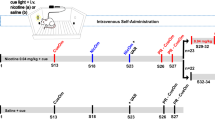Abstract
The debate about electronic cigarettes is dividing healthcare professionals, policymakers, manufacturers, and communities. A key limitation in our understanding of the cause and consequences of vaping is the lack of animal models of nicotine vapor self-administration. Here, we developed a novel model of voluntary electronic cigarette use in rats using operant behavior. We found that rats voluntarily exposed themselves to nicotine vapor to the point of reaching blood nicotine levels that are similar to humans. The level of responding on the active (nicotine) lever was similar to the inactive (air) lever and lower than the active lever that was associated with vehicle (polypropylene glycol/glycerol) vapor, suggesting low positive reinforcing effects and low nicotine vapor discrimination. Lever pressing behavior with nicotine vapor was pharmacologically prevented by the α4β2 nicotinic acetylcholine receptor partial agonist and α7 receptor full agonist varenicline in rats that self-administered nicotine but not vehicle vapor. Moreover, 3 weeks of daily (1 h) nicotine vapor self-administration produced addiction-like behaviors, including somatic signs of withdrawal, allodynia, anxiety-like behavior, and relapse-like behavior after 3 weeks of abstinence. Finally, 3 weeks of daily (1 h) nicotine vapor self-administration produced cardiopulmonary abnormalities and changes in α4, α3, and β2 nicotinic acetylcholine receptor subunit mRNA levels in the nucleus accumbens and medial prefrontal cortex. These findings validate a novel animal model of nicotine vapor self-administration in rodents with relevance to electronic cigarette use in humans and highlight the potential addictive properties and harmful effects of chronic nicotine vapor self-administration.
Similar content being viewed by others
Log in or create a free account to read this content
Gain free access to this article, as well as selected content from this journal and more on nature.com
or
Data and material availability
All data are available in the main text or in Supplementary Material.
References
Services UDOHAH. E-cigarette use among youth and young adults: a report of the surgeon general. Atlanta, GA: US Department of Health and Human Services; 2016.
Luxton NA, Shih P, Rahman MA, Electronic cigarettes and smoking cessation in the perioperative period of cardiothoracic surgery: views of australian clinicians. Int J Environ Res Public Health. 2018;15:11.
Fong GT, Elton-Marshall T, Driezen P, Kaufman AR, Cummings KM, Choi K. et al. U.S. adult perceptions of the harmfulness of tobacco products: descriptive findings from the 2013–14 baseline wave 1 of the path study. Addict Behav. 2019;91:180–7.
Mathur A, Dempsey OJ. Electronic cigarettes: a brief update. J R Coll Physicians Edinb. 2018;48:346–51.
Mead EL, Duffy V, Oncken C, Litt MD. E-cigarette palatability in smokers as a function of flavorings, nicotine content and propylthiouracil (PROP) taster phenotype. Addict Behav. 2019;91:37–44.
Takahashi Y, Kanemaru Y, Fukushima T, Eguchi K, Yoshida S, Miller-Holt J. et al. Chemical analysis and in vitro toxicological evaluation of aerosol from a novel tobacco vapor product: a comparison with cigarette smoke. Regul Toxicol Pharm. 2018;92:94–103.
Taylor M, Carr T, Oke O, Jaunky T, Breheny D, Lowe F. et al. E-cigarette aerosols induce lower oxidative stress in vitro when compared to tobacco smoke. Toxicol Mech Methods. 2016;26:465–76.
Sifat AE, Vaidya B, Kaisar MA, Cucullo L, Abbruscato TJ. Nicotine and electronic cigarette (E-Cig) exposure decreases brain glucose utilization in ischemic stroke. J Neurochem. 2018;147:204–21.
Shen Y, Wolkowicz MJ, Kotova T, Fan L, Timko MP. Transcriptome sequencing reveals e-cigarette vapor and mainstream-smoke from tobacco cigarettes activate different gene expression profiles in human bronchial epithelial cells. Sci Rep. 2016;6:23984.
Rankin GD, Wingfors H, Uski O, Hedman L, Ekstrand-Hammarstrom B, Bosson J. et al. The toxic potential of a fourth-generation E-cigarette on human lung cell lines and tissue explants. J Appl Toxicol. 2019;39:1143–54.
Zagoriti Z, El Mubarak MA, Farsalinos K, Topouzis S. Effects of exposure to tobacco cigarette, electronic cigarette and heated tobacco product on adipocyte survival and differentiation in vitro. Toxics. 2020;8:9.
Welz C, Canis M, Schwenk-Zieger S, Becker S, Stucke V, Ihler F. et al. Cytotoxic and genotoxic effects of electronic cigarette liquids on human mucosal tissue cultures of the oropharynx. J Environ Pathol Toxicol Oncol. 2016;35:343–54.
Cohen A, George O. Animal models of nicotine exposure: relevance to second-hand smoking, electronic cigarette use, and compulsive smoking. Front Psychiatry. 2013;4:41.
Erku DA, Gartner CE, Do JT, Morphett K, Steadman KJ. Electronic nicotine delivery systems (e-cigarettes) as a smoking cessation aid: a survey among pharmacy staff in Queensland, Australia. Addict Behav. 2019;91:227–33.
Filippidis FT, Laverty AA, Mons U, Jimenez-Ruiz C, Vardavas CI. Changes in smoking cessation assistance in the European Union between 2012 and 2017: pharmacotherapy versus counselling versus e-cigarettes. Tob Control. 2019;28:95–100.
Donny EC, Caggiula AR, Mielke MM, Jacobs KS, Rose C, Sved AF. Acquisition of nicotine self-administration in rats: the effects of dose, feeding schedule, and drug contingency. Psychopharmacology. 1998;136:83–90.
Belluzzi JD, Wang R, Leslie FM. Acetaldehyde enhances acquisition of nicotine self-administration in adolescent rats. Neuropsychopharmacology. 2005;30:705–12.
Jensen RP, Luo W, Pankow JF, Strongin RM, Peyton DH. Hidden formaldehyde in e-cigarette aerosols. N Engl J Med. 2015;372:392–4.
El-Hellani A, Al-Moussawi S, El-Hage R, Talih S, Salman R, Shihadeh A. et al. Carbon monoxide and small hydrocarbon emissions from sub-ohm electronic cigarettes. Chem Res Toxicol. 2019;32:312–7.
Kallupi M, George O. Nicotine vapor method to induce nicotine dependence in rodents. Curr Protoc Neurosci. 2017;80:84141–484110.
Gilpin NW, Whitaker AM, Baynes B, Abdel AY, Weil MT, George O. Nicotine vapor inhalation escalates nicotine self-administration. Addict Biol. 2014;19:587–92.
Malin DH, Lake JR, Carter VA, Cunningham JS, Hebert KM, Conrad DL. et al. The nicotinic antagonist mecamylamine precipitates nicotine abstinence syndrome in the rat. Psychopharmacology. 1994;115:180–4.
Vendruscolo JCM, Tunstall BJ, Carmack SA, Schmeichel BE, Lowery-Gionta EG, Cole M. et al. Compulsive-like sufentanil vapor self-administration in rats. Neuropsychopharmacology. 2018;43:801–9.
Hiler M, Breland A, Spindle T, Maloney S, Lipato T, Karaoghlanian N. et al. Electronic cigarette user plasma nicotine concentration, puff topography, heart rate, and subjective effects: Influence of liquid nicotine concentration and user experience. Exp Clin Psychopharmacol. 2017;25:380–92.
Vansickel AR, Edmiston JS, Liang Q, Duhon C, Connell C, Bennett D. et al. Characterization of puff topography of a prototype electronic cigarette in adult exclusive cigarette smokers and adult exclusive electronic cigarette users. Regul Toxicol Pharm. 2018;98:250–6.
Russell MA, Feyerabend C, Cole PV. Plasma nicotine levels after cigarette smoking and chewing nicotine gum. Br Med J. 1976;1:1043–6.
Farsalinos KE, Spyrou A, Tsimopoulou K, Stefopoulos C, Romagna G, Voudris V. Nicotine absorption from electronic cigarette use: comparison between first and new-generation devices. Sci Rep. 2014;4:4133.
Malin DH, Lake JR, Newlin-Maultsby P, Roberts LK, Lanier JG, Carter VA. et al. Rodent model of nicotine abstinence syndrome. Pharm Biochem Behav. 1992;43:779–84.
George O, Grieder TE, Cole M, Koob GF. Exposure to chronic intermittent nicotine vapor induces nicotine dependence. Pharm Biochem Behav. 2010;96:104–107.
Pellow S, Chopin P, File SE, Briley M. Validation of open:closed arm entries in an elevated plus-maze as a measure of anxiety in the rat. J Neurosci Methods. 1985;14:149–67.
Elliott BM, Faraday MM, Grunberg NE. Effects of nicotine on heart dimensions and blood volume in male and female rats. Nicotine Tob Res. 2003;5:341–8.
Gourlay SG, Benowitz NL. Arteriovenous differences in plasma concentration of nicotine and catecholamines and related cardiovascular effects after smoking, nicotine nasal spray, and intravenous nicotine. Clin Pharmacol Therapeutics. 1997;62:453–63.
Shoaib M, Stolerman IP. Plasma nicotine and cotinine levels following intravenous nicotine self-administration in rats. Psychopharmacology. 1999;143:318–21.
Miller RP, Rotenberg KS, Adir J. Effect of dose on the pharmacokinetics of intravenous nicotine in the rat. Drug Metab Dispos. 1977;5:436–43.
Cohen A, Treweek J, Edwards S, Leao RM, Schulteis G, Koob GF. et al. Extended access to nicotine leads to a CRF1 receptor dependent increase in anxiety-like behavior and hyperalgesia in rats. Addict Biol. 2015;20:56–68.
Valentine JD, Hokanson JS, Matta SG, Sharp BM. Self-administration in rats allowed unlimited access to nicotine. Psychopharmacology. 1997;133:300–4.
Donny EC, Caggiula AR, Rowell PP, Gharib MA, Maldovan V, Booth S. et al. Nicotine self-administration in rats: estrous cycle effects, sex differences and nicotinic receptor binding. Psychopharmacology. 2000;151:392–405.
Rosenzweig-Lipson S, Thomas S, Barrett JE. Attenuation of the locomotor activating effects of D-amphetamine, cocaine, and scopolamine by potassium channel modulators. Prog Neuropsychopharmacol Biol Psychiatry. 1997;21:853–72.
Corrigall WA, Coen KM. Nicotine maintains robust self-administration in rats on a limited-access schedule. Psychopharmacology. 1989;99:473–8.
Fudala PJ, Iwamoto ET. Further studies on nicotine-induced conditioned place preference in the rat. Pharm Biochem Behav. 1986;25:1041–9.
Morean ME, Kong G, Cavallo DA, Camenga DR, Krishnan-Sarin S. Nicotine concentration of e-cigarettes used by adolescents. Drug Alcohol Depend. 2016;167:224–7.
Henningfield JE, Goldberg SR. Nicotine as a reinforcer in human subjects and laboratory animals. Pharm Biochem Behav. 1983;19:989–92.
George O, Lloyd A, Carroll FI, Damaj MI, Koob GF. Varenicline blocks nicotine intake in rats with extended access to nicotine self-administration. Psychopharmacology. 2011;213:715–22.
Coe JW, Brooks PR, Vetelino MG, Wirtz MC, Arnold EP, Huang J. et al. Varenicline: an alpha4beta2 nicotinic receptor partial agonist for smoking cessation. J Med Chem. 2005;48:3474–7.
Baiamonte BA, Valenza M, Roltsch EA, Whitaker AM, Baynes BB, Sabino V. et al. Nicotine dependence produces hyperalgesia: role of corticotropin-releasing factor-1 receptors (CRF1Rs) in the central amygdala (CeA). Neuropharmacology. 2014;77:217–23.
Kallupi M, de Guglielmo G, Larrosa E, George O. Exposure to passive nicotine vapor in male adolescent rats produces a withdrawal-like state and facilitates nicotine self-administration during adulthood. Eur Neuropsychopharmacol. 2019;29:1227–34.
Damaj MI, Kao W, Martin BR. Characterization of spontaneous and precipitated nicotine withdrawal in the mouse. J Pharmacol Exp therapeutics. 2003;307:526–34.
Paterson NE, Markou A. Prolonged nicotine dependence associated with extended access to nicotine self-administration in rats. Psychopharmacology. 2004;173:64–72.
Hughes JR, Peters EN, Callas PW, Peasley-Miklus C, Oga E, Etter JF. et al. Withdrawal symptoms from e-cigarette abstinence among former smokers: a pre-post clinical trial. Nicotine Tob Res. 2019;22:734–9.
Bailey SA, Zidell RH, Perry RW. Relationships between organ weight and body/brain weight in the rat: what is the best analytical endpoint? Toxicol Pathol. 2004;32:448–66.
Michael B, Yano B, Sellers RS, Perry R, Morton D, Roome N. et al. Evaluation of organ weights for rodent and non-rodent toxicity studies: a review of regulatory guidelines and a survey of current practices. Toxicol Pathol. 2007;35:742–50.
Yu C, Zhang Z, Liu Y, Zong Y, Chen Y, Du X. et al. Toxicity of smokeless tobacco extract after 184-day repeated oral administration in rats. Int J Environ Res Public Health. 2016;13:281.
Ambrose JA, Barua RS. The pathophysiology of cigarette smoking and cardiovascular disease: an update. J Am Coll Cardiol. 2004;43:1731–7.
Garcia-Arcos I, Geraghty P, Baumlin N, Campos M, Dabo AJ, Jundi B, et al. Chronic electronic cigarette exposure in mice induces features of COPD in a nicotine-dependent manner. Thorax. 2016;71:1119–29.
Anderson AE Jr., Hernandez JA, Eckert P, Foraker AG. Emphysema in lung macrosections correlated with smoking habits. Science. 1964;144:1025–6.
Branchfield K, Nantie L, Verheyden JM, Sui P, Wienhold MD, Sun X. Pulmonary neuroendocrine cells function as airway sensors to control lung immune response. Science. 2016;351:707–10.
Schweitzer KS, Chen SX, Law S, Van Demark M, Poirier C, Justice MJ. et al. Endothelial disruptive proinflammatory effects of nicotine and e-cigarette vapor exposures. Am J Physiol Lung Cell Mol Physiol. 2015;309:L175–87.
McConnell R, Barrington-Trimis JL, Wang K, Urman R, Hong H, Unger J. et al. Electronic cigarette use and respiratory symptoms in adolescents. Am J Respir Crit Care Med. 2017;195:1043–9.
Ledford H. Scientists chase cause of mysterious vaping illness as death toll rises. Nature. 2019;574:303–4.
Leung JM, Tiew PY, Mac Aogain M, Budden KF, Yong VF, Thomas SS. et al. Pethe K, Hansbro PM, Chotirmall SH. The role of acute and chronic respiratory colonization and infections in the pathogenesis of COPD. Respirology. 2017;22:634–50.
Sussan TE, Gajghate S, Thimmulappa RK, Ma J, Kim JH, Sudini K. et al. Exposure to electronic cigarettes impairs pulmonary anti-bacterial and anti-viral defenses in a mouse model. PLoS ONE. 2015;10:e0116861.
Marks MJ, Burch JB, Collins AC. Effects of chronic nicotine infusion on tolerance development and nicotinic receptors. J Pharmacol Exp therapeutics. 1983;226:817–25.
Schwartz RD, Kellar KJ. Nicotinic cholinergic receptor binding sites in the brain: regulation in vivo. Science. 1983;220:214–6.
Benwell ME, Balfour DJ, Anderson JM. Evidence that tobacco smoking increases the density of (-)-[3H]nicotine binding sites in human brain. J Neurochem. 1988;50:1243–7.
Marks MJ, Stitzel JA, Collins AC. Time course study of the effects of chronic nicotine infusion on drug response and brain receptors. J Pharmacol Exp therapeutics. 1985;235:619–28.
Markou A. Review. Neurobiology of nicotine dependence. Philos Trans R Soc Lond B Biol Sci. 2008;363:3159–68.
Marks MJ, Pauly JR, Gross SD, Deneris ES, Hermans-Borgmeyer I, Heinemann SF. et al. Nicotine binding and nicotinic receptor subunit RNA after chronic nicotine treatment. J Neurosci. 1992;12:2765–84.
Chen H, Parker SL, Matta SG, Sharp BM. Gestational nicotine exposure reduces nicotinic cholinergic receptor (nAChR) expression in dopaminergic brain regions of adolescent rats. Eur J Neurosci. 2005;22:380–8.
Picciotto MR, Kenny PJ. Molecular mechanisms underlying behaviors related to nicotine addiction. Cold Spring Harb Perspect Med. 2013;3:a012112.
Improgo MR, Scofield MD, Tapper AR, Gardner PD. The nicotinic acetylcholine receptor CHRNA5/A3/B4 gene cluster: dual role in nicotine addiction and lung cancer. Prog Neurobiol. 2010;92:212–26.
Freels TG, Baxter-Potter LN, Lugo JM, Glodosky NC, Wright HR, Baglot SL. et al. Vaporized cannabis extracts have reinforcing properties and support conditioned drug-seeking behavior in rats. J Neurosci. 2020;40:1897–908.
Acknowledgements
The authors thank Michael Arends for proofreading the manuscript.
Author information
Authors and Affiliations
Contributions
MKa and OG designed the vapor self-administration experiment. GdG and MKl built the vapor self-administration chambers. LCS, SS, and LT performed the self-administration experiments. LCS, NV, and LT performed the behavioral experiments. LCS, GdG, JB, and YS harvested the organs. XS designed the pulmonary dysfunction experiment. AJ performed the tissue analysis. KS performed the receptor subunit experiments. LCS, LLGC, and MKa analyzed the data. LCS generated the figures. LCS prepared the manuscript and Supplementary Material. MKa and OG edited the manuscript and Supplementary Material. All of the authors reviewed the final version of the manuscript.
Corresponding authors
Additional information
Publisher’s note Springer Nature remains neutral with regard to jurisdictional claims in published maps and institutional affiliations.
Supplementary information
Rights and permissions
About this article
Cite this article
Smith, L.C., Kallupi, M., Tieu, L. et al. Validation of a nicotine vapor self-administration model in rats with relevance to electronic cigarette use. Neuropsychopharmacol. 45, 1909–1919 (2020). https://doi.org/10.1038/s41386-020-0734-8
Received:
Revised:
Accepted:
Published:
Issue date:
DOI: https://doi.org/10.1038/s41386-020-0734-8
This article is cited by
-
Acute nicotine vapor attenuates sensorimotor gating deficits in HIV-1 transgenic rats
Psychopharmacology (2025)
-
The influence of stress and social defeat on neurobiological reinforcement mechanisms across reward to withdrawal in nicotine addiction
Psychopharmacology (2025)
-
Effect of chronic vapor nicotine exposure on affective and cognitive behavior in male mice
Scientific Reports (2024)
-
Factors influencing JUUL e-cigarette nicotine vapour-induced reward, withdrawal, pharmacokinetics and brain connectivity in rats: sex matters
Neuropsychopharmacology (2024)
-
Adult consequences of repeated nicotine and Δ9-tetrahydrocannabinol (THC) vapor inhalation in adolescent rats
Psychopharmacology (2024)



